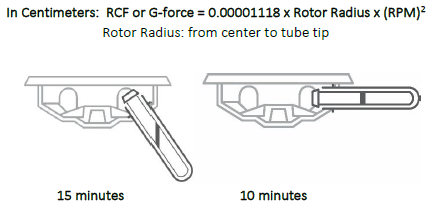
Summary
Horizontal centrifugation preserves the integrity of blood specimens. It has become the standard used by reference and hospital laboratories worldwide.
Benefits of Horizontal
A Stronger Gel Barrier
In horizontal centrifugation, the thickest & most stable gel layer is achieved. In fixed angle centrifugation, the gel barrier layer is formed at a 45-degree angle to the tube and the same volume of gel must seal 40% more surface area than when spun in a horizontal centrifuge.
Post centrifugation, gravity and transportation to the lab encourage the layer to reposition and can break the seal. Remixing of the layers allows the blood to continue to metabolize, negating the positive effects of blood separation within 2 hours from draw and reducing specimen integrity.
Why It Matters
Leakage of the weak gel seal produced by fixed-angle centrifugation alters plasma/serum chemistry and produces inaccurate diagnostic results.
Tubes spun in a horizontal centrifuge produce more plasma or serum for analysis, lead to fewer clogged analyzer probes, and allow for primary tube sampling.
Larger Radius • Higher RCF • Shorter Spin Time
Tubes centrifuged in a horizontal centrifuge experience a larger radius, resulting in a higher RCF and more efficient forces. Higher g-forces produce a better seal with the tube wall due to better gel packing. The time required for complete centrifugation is only 2/3 of the time required in a fixed-angle centrifuge.

What Experts Say

Clinical and Laboratory Standards Institute • GP44-A4 Standard
“When using a fixed-angle centrifuge, and if serum is stored on the gel, visual inspection of the tube is necessary to check for completeness of the barrier due to the fact that the gel has formed at a 45-degree angle and may not provide an adequate seal. Tube manufacturer guidelines for both speed and time should be consulted based on the type of centrifuge used.”
“Barrier formation is more predictable with swing-bucket centrifuges.”

BD • Vacutainer® Evacuated Blood Collection System • I.F.U.
“Tubes should not be re-centrifuged once the barrier has formed. Barriers are more stable when tubes are spun in centrifuges with horizontal (swinging bucket) heads than those with fixed angle heads.”

Greiner Bio-One • Vacuette® Blood Collection System • I.F.U.
“Barriers are more stable when tubes are spun in centrifuges with horizontal swing-out rotors rather than those with fixed angle heads.”
NOTE: It is not recommended to re-centrifuge tubes once the barrier has been formed.
Impact on Chemical Analysis: A Sampling of Studies
Pseudonormokalaemia Caused by Re-centrifugation of Blood Samples after Storage in Gel-Separator Tubes.
“We showed that re-centrifugation of blood specimens after storage in gel-separator tubes caused pseudohyperkalaemia. Stopping the practice of recentrifugation resulted in the reduction of 11.1% to 4.1% in the apparent frequency of hyperkalaemia.”
“Re-centrifugation could also cause pseudonormokalaemia, raising the concern that we may have overlooked a substantial number of patients with hypokalaemia. This may affect patients with Cushing’s syndrome (hyperadrenocorticism,), hypokalaemic periodic paralysis, and hyperaldosteronism.”
Impact of Pre-Analytical Parameters on the Measurement of Circulating Microparticles: towards Standardization of Protocol
“The main results show that the three major pre-analytical parameters which impact on MP-related data are the delay before the first centrifugation, agitation of the tubes during transportation, and following centrifugation protocol.”
The Effect of Re-centrifugation of Serum Separator Tubes on Concentration of Serum Analytes
“We hypothesize that re-solidified gel during secondary centrifugation becomes slightly permeable, allowing some analytes (which have leaked-out from the cells) to cross into the serum or plasma. Results show that re-centrifugation increased the concentrations of glucose, sodium, potassium, creatinine, bicarbonate, phosphorous and magnesium significantly… Potassium and creatinine had the most marked increase in concentration following re-centrifugation.”
Observed Changes in Serum Potassium Concentration Following Repeat Centrifugation of Sarstedt Serum Gel Safety Monovettes® after Storage
Samples subject to re-centrifugation showed elevated readings of serum potassium concentration.
Effect of Storage Temperature and Time before Centrifugation on Ionized Calcium in Blood Collected in Plain Vacutainer© Tubes and SST© Tubes.
“Blood may remain uncentrifuged at room temperature for as long as 2 hours without appreciable change in concentration of ionized calcium.”
